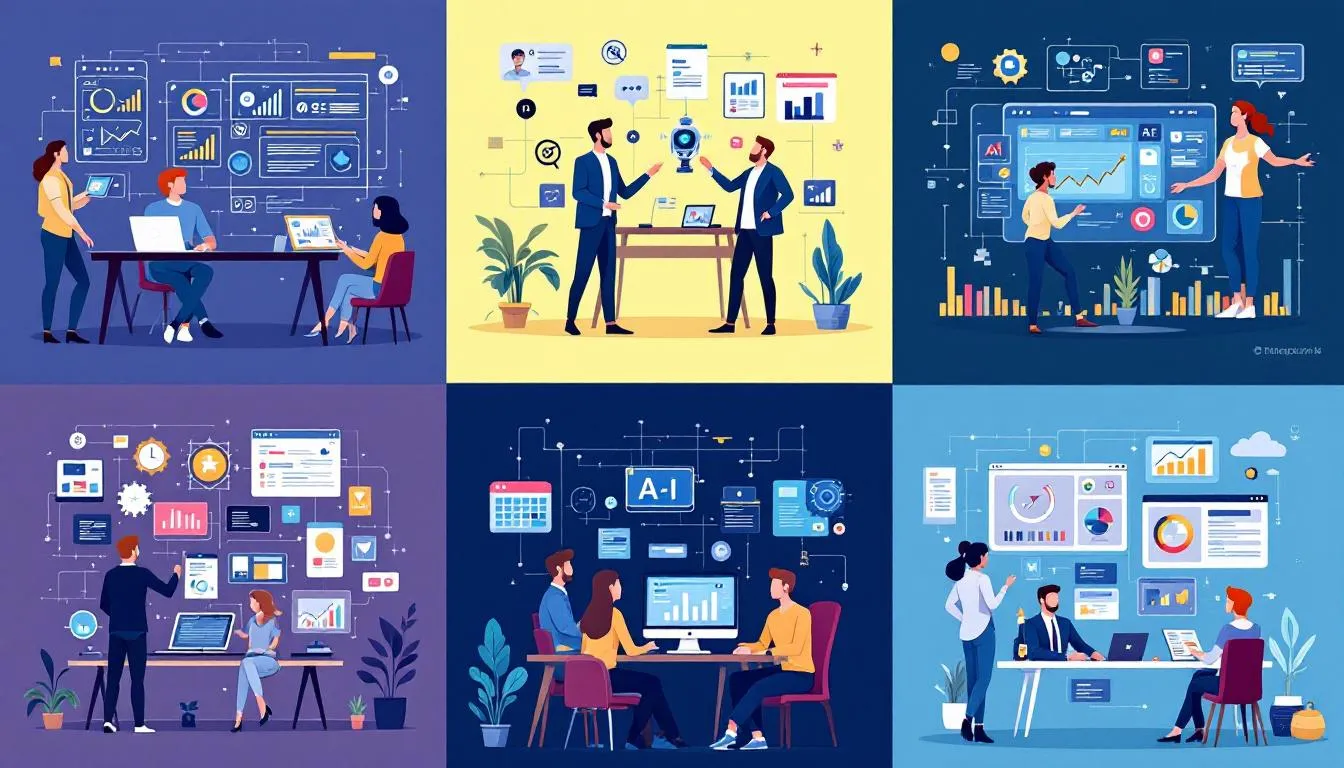
Top Strategies for Effective AI Training for Employees
AI training for employees is no longer optional. To stay competitive, businesses need to equip their teams with the skills to use AI technologies effectively. This article will cover the importance of AI training, the fundamental concepts employees need to know, and practical steps for designing and implementing successful AI training programs.
Key Takeaways
- AI training is essential for enhancing employee productivity and ensuring companies remain competitive in a rapidly evolving technological landscape.
- Effective AI training programs must be tailored to specific roles and leverage diverse resources to meet the varying needs of employees.
- Promoting AI literacy and addressing equity gaps in training are crucial for fostering an inclusive workforce capable of leveraging AI technologies.
Why AI Training is Crucial for Today’s Workforce

In today’s rapidly evolving technological landscape, AI training is not just a luxury but a necessity. Integrating AI into business operations is essential for companies to thrive and remain competitive. AI has the power to enhance productivity, drive innovation, and enable businesses to offer new and improved services. Investing in AI training helps companies fill skill gaps, equipping their workforce with the tools needed to excel in their roles.
AI training boosts frontline workers’ productivity and fosters a culture enthusiastic about AI, giving companies a competitive edge. Companies that fail to provide proper AI training to their employees risk falling behind in terms of productivity and innovation. Embracing AI can significantly increase operational efficiency, allowing businesses to automate routine tasks and focus on strategic decision-making to boost productivity.
Investing in AI training aligns with business needs and meets employee desires for skill development. Employees are increasingly seeking opportunities to learn and grow, and AI training offers a pathway to enhance their capabilities. Deploying AI training across all workforce levels provides significant business, talent, and ESG advantages. This not only improves employee engagement but also positions the company strategically in the market.
Organizations must engage in ongoing education related to AI and emerging technologies to remain competitive. Continuous learning is crucial in an AI-driven landscape, and companies that embrace this mindset will be better positioned to adapt to technological advancements. As AI continues to evolve, ongoing training initiatives will ensure that employees stay updated with the latest tools and technologies, maintaining the company’s competitive advantage.
Understanding AI Fundamentals
For employees to effectively incorporate AI into their work processes, a solid understanding of AI fundamentals is essential. AI encompasses a variety of technologies that enable machines to perform tasks that typically require human intelligence, such as data analysis, natural language processing, and decision-making. Familiarity with these key AI tools and technologies is crucial for leveraging AI to drive strategic business decisions.
In the following subsections, we will dive deeper into what AI is and explore the key technologies and tools that form the backbone of AI systems. This foundational knowledge will empower employees to use AI effectively and contribute to the organization’s success.
What is Artificial Intelligence?
Artificial Intelligence (AI) has come a long way since its inception, evolving from simple algorithms to complex systems capable of performing tasks that typically require human intelligence. Mainstream machine learning experiments began in the 1950s, leading to significant breakthroughs such as personal calculators, personal computers, and personal assistants like Siri and Alexa. These advancements have paved the way for more sophisticated AI applications in various industries.
Generative AI, for instance, refers to AI models that generate content in response to a prompt, creating new possibilities for creativity and innovation. As AI continues to evolve, it is projected that up to 30% of tasks could potentially be automated by 2030, highlighting the transformative impact of AI on the workforce.
Understanding the basics of AI, including its capabilities, types, risks, best practices, and ethical usage, is crucial for employees to navigate the AI landscape effectively.
Key AI Technologies and Tools
AI incorporates various technologies, including:
- Machine learning: a critical component that allows systems to learn and adapt from data without explicit programming, enabling more accurate predictions and decision-making. AI and machine learning enhance this process significantly.
- Natural language processing (NLP): enables machines to understand and process human language, facilitating better human-computer interactions.
- Computer vision: plays a crucial role in different applications (though not further detailed here).
Generative AI tools, such as those used for content creation, are revolutionizing industries by automating creative processes and generating new ideas based on the data they are trained on. This genai tool can be applied in various fields, from marketing to software development, enhancing productivity and innovation. Familiarity with these AI technologies, genai tools, and tools is essential for employees to integrate AI effectively into their work processes.
Leveraging AI tools and technologies allows companies to analyze vast amounts of data science, leading to insights that can drive strategic decision-making for decision makers. Understanding how technology works and its applications enables employees to contribute to informed business decisions, helping the organization stay competitive.
Designing Effective AI Training Programs
Designing effective AI training programs is crucial for helping employees enhance their skills and adapt to new technologies. These programs should focus on providing employees with the tools and skills that allow them to do their job faster and better, ultimately optimizing business operations. The main objectives of AI skilling investments include skills adoption, employee engagement, and accessibility, ensuring that all employees can benefit from AI advancements.
To achieve these objectives, AI training needs to be tailored to specific roles and leverage external resources such as local universities and online platforms. This ensures that employee training is relevant, effective, and accessible to all employees, regardless of their position within the company. Proper training helps to train employees effectively to maximize their potential through a well-structured course.
In the following subsections, we will explore how to customize training for different roles and how to utilize local universities and online resources to enhance AI training programs.
Customizing Training for Different Roles
Tailoring AI training programs to specific roles enhances their relevance and effectiveness, as different job functions have unique AI needs. For example, data scientists may require in-depth training on machine learning algorithms, while marketing professionals might benefit more from learning about AI-driven customer insights tools. Considering the various AI needs of employees allows companies to create targeted and impactful training programs.
AI is increasingly being used to identify skill gaps in real time, allowing organizations to tailor training programs more effectively and provide personalized training experiences. This approach not only improves the relevance of the training but also enhances employee engagement and retention, leveraging ai skills and ai knowledge.
Evaluating the effectiveness of AI training requires a structured strategy that focuses on long-term productivity metrics rather than short-term gains, ensuring that the training has a lasting impact on employee performance.
The growing importance of AI in workplace learning is underscored by the projected $6 billion market for AI training by 2025. This highlights the need for companies to invest in customized AI training programs that address the specific needs of their employees and help them develop the skills necessary to thrive in an AI-driven workplace.
Leveraging Local Universities and Online Resources
Collaborating with local universities and utilizing online platforms can enrich AI training programs, providing diverse learning opportunities for employees. Local universities often offer specialized courses and expertise that can complement internal training initiatives, while online platforms provide flexibility and accessibility, allowing employees to learn at their own pace and according to their specific needs. This combination of resources can lead to better skill retention and overall training effectiveness.
Adopting platforms for continuous education is crucial for future-proofing the workforce and ensuring that all employees have access to relevant programs tailored to their needs. By offering accessible and diverse training programs, companies can help employees develop the necessary AI-related skills and adapt to the evolving demands of the workplace.
Ensuring accessibility and inclusivity in AI training is key to successful skilling investments and long-term business success.
Implementing AI Literacy Training

Implementing AI literacy training across the workforce is essential to ensure that all employees possess the knowledge and skills to effectively utilize AI. Proper AI training programs should prioritize skill adoption, employee engagement, and equitable access to ensure that all employees benefit from AI advancements. This foundational knowledge will enable employees to understand what is happening with AI, why it matters, and how to leverage it in their work.
In the following subsections, we will discuss how to promote AI literacy across the workforce and address equity gaps in AI training. These initiatives will help create an inclusive and knowledgeable workforce that can adapt to the changes brought about by AI.
Promoting AI Literacy Across the Workforce
Promoting AI literacy across the workforce is crucial for enhancing adaptability and competitiveness in an increasingly AI-driven landscape. Key considerations for effective AI training include:
- Encouraging employee-led training choices to boost engagement and effectiveness in skill acquisition.
- Ensuring AI training meets both employer and employee needs.
- Structuring training for varying skill levels.
- Covering the basics of AI.
- Addressing ethical use of AI.
- Providing hands-on experience.
Creating an environment that encourages ongoing education can significantly enhance workforce resilience and adaptability. Promoting AI literacy ensures employees are well-equipped to navigate the AI landscape and contribute to organizational success.
Addressing Equity Gaps in AI Training
Creating inclusive AI training programs is essential for bridging the skills gap among diverse employee groups. Many AI training programs require a bachelor’s degree, limiting access for some demographics. To address this, companies should focus on providing accessible training programs that do not have stringent educational prerequisites, ensuring that all employees have the opportunity to develop AI-related skills.
Utilizing diverse and representative datasets in AI training can help minimize bias in AI systems and promote fairness. Implementing diverse training datasets can ensure fairer outcomes and help reduce bias in AI models. Addressing equity gaps in AI training fosters a more inclusive and effective workforce, better prepared to leverage AI technologies.
Practical Applications of AI in the Workplace

Practical applications of AI in the workplace demonstrate the transformative potential of AI tools and technologies. Real-world examples of AI enhancing frontline operations include automated customer service chatbots and AI-driven inventory management systems, which streamline operations and improve efficiency. AI automates repetitive tasks, freeing human resources for complex and creative functions, and enabling employees to focus on strategic decision-making.
AI-driven insights enable better decision-making by providing data analysis and predicting outcomes that help organizations adapt quickly. For instance, AI can analyze customer data to identify trends and preferences, allowing businesses to tailor their offerings and improve customer satisfaction. The ability to leverage AI for data-driven decision-making is a significant advantage in today’s competitive market.
The future potential of AI in various business functions promises further enhancements in efficiency, accuracy, and decision-making capabilities. As AI technology continues to evolve, its applications will expand, offering new opportunities for innovation and growth. Encouraging employees to explore and experiment with AI tools can lead to increased employee engagement and performance, ultimately benefiting the organization as a whole.
Overcoming Challenges in AI Training
While the benefits of AI training are clear, organizations often face challenges in implementing these training programs. Managing the culture around AI is crucial to ensure successful implementation and acceptance of AI training initiatives within organizations. Addressing data acquisition is also essential for successful AI training, as it requires large amounts of high-quality data.
In the following subsections, we will explore how to mitigate ethical concerns and bias in AI training and ensure data privacy and security. These strategies will help organizations overcome common challenges and create effective AI training programs that benefit the entire workforce.
Mitigating Ethical Concerns and Bias
Ethical considerations are paramount when implementing AI training programs. Key aspects include:
- Establishing clear ethical guidelines to prevent biases in AI models.
- Ensuring AI systems do not reinforce existing societal biases.
- Implementing bias-aware algorithms to actively identify and mitigate potential biases during AI development.
This approach not only promotes fairness but also builds trust in AI systems among employees and stakeholders.
Encouraging critical thinking and informed decision-making among employees can also help address ethical concerns. By providing training on the ethical implications of AI and promoting a better understanding of the potential risks and benefits, organizations can empower their workforce to make ethical decisions and contribute to the responsible use of AI technologies.
Ensuring Data Privacy and Security
Data privacy and security are critical components of AI training programs. Implementing data anonymization techniques helps protect personal information in AI training datasets, ensuring compliance with privacy regulations and maintaining customer trust. Employing federated learning allows models to learn from data without transferring it, further enhancing privacy and reducing the risk of data breaches.
Regular audits and monitoring of AI systems are essential to maintain data privacy and prevent unauthorized access. Safeguarding confidential data is crucial for building trust with customers and complying with regulatory requirements. By prioritizing data privacy, privacy concerns, and data security in AI training, organizations can create a secure environment that fosters the responsible use of AI technologies.
Measuring the Impact of AI Training
Measuring the impact of AI training programs is crucial for ensuring that employees are effectively utilizing the skills acquired. Key metrics for evaluating AI training success include employee engagement, productivity improvements, and return on investment (ROI). Tracking these metrics allows organizations to assess the impact of their training investments and make data-driven enhancements to their programs.
Continuous improvement and feedback loops are essential for refining AI training programs based on real-time data and employee responses. Incorporating feedback mechanisms, such as real-time surveys and AI-driven analytics, can help organizations identify trends and gaps in training effectiveness, facilitating continuous improvement.
Regular auditing of AI systems can also help ensure compliance and rectify any ethical standards issues or existing biases that may arise during their operation.
Key Metrics for Evaluating AI Training Success
Labor productivity before and after AI training is a critical measure that helps organizations assess the real impact of their training investments. Key aspects to monitor include:
- Monitoring workflows to identify time savings from automation, which is essential for determining the ROI of AI training initiatives.
- Tracking specific business KPIs related to customer satisfaction.
- Tracking KPIs related to error reduction to measure the impact of AI training over time.
Encouraging ongoing education can significantly enhance employee engagement and retention, ultimately benefiting the organization. Measuring the return on investment (ROI) from AI training can highlight its financial impact on the organization and justify further investments in training initiatives, leading to cost savings.
Continuous Improvement and Feedback Loops
Incorporating feedback mechanisms, such as real-time surveys or chatbots during training, can enhance the evaluation of program effectiveness and guide future improvements. Feedback mechanisms should measure not just completion rates but also the practical application and integration of skills in the workplace. Utilizing AI-driven analytics can help organizations identify trends and gaps in training effectiveness, facilitating continuous improvement.
Regular auditing of AI systems is essential to identify and rectify any ethical issues or biases that may arise during their operation. Focusing on continuous improvement ensures AI training programs remain effective and relevant amid technological changes.
Preparing for the Future of Work with AI

Continuous learning is essential in adapting to the changes brought about by AI in the workplace. As AI technology continues to evolve, employees must be equipped with the skills needed to navigate this new landscape. A workforce that embraces continuous learning will be better positioned to thrive amid rapid AI advancements.
In the following subsections, we will discuss the importance of building a culture of lifelong learning and anticipating future AI trends and skills. These strategies will help organizations prepare their workforce for the future of work with AI.
Building a Culture of Lifelong Learning
Developing a culture that prioritizes ongoing skill enhancement is vital for adapting to technological advancements. Key points include:
- Implementing continuous feedback mechanisms can significantly boost employee retention rates.
- Organizations using AI-driven feedback tools can experience up to a 25% increase in employee satisfaction.
- This highlights the importance of continuous learning and feedback in driving employee engagement.
Encouraging many employees to pursue new skills and knowledge through workplace training programs can lead to revenue growth and better business outcomes for business leaders. To encourage employees to foster a culture of lifelong learning ensures the workforce remains adaptable and resilient amid technological changes.
Anticipating Future AI Trends and Skills
The future job market will significantly shift towards an increased demand for both technical capabilities and human skills due to advancements in AI technology. As the reliance on AI increases, employees will need technical skills related to AI implementation and soft skills like emotional intelligence to excel in their roles. Creative problem-solving and emotional intelligence are emerging as increasingly important skills for adapting to the AI-driven workplace, particularly for desk workers.
Adopting a mindset of continuous learning and adaptability will be key for professionals aiming to thrive in an increasingly AI-oriented job landscape. By anticipating future emerging trends in AI and skills, organizations can better prepare their workforce for the challenges and opportunities ahead.
Summary
In conclusion, effective AI training for employees is crucial for thriving in today’s rapidly evolving technological landscape. By understanding AI fundamentals, designing tailored training programs, promoting AI literacy, and addressing equity gaps, organizations can create a knowledgeable and adaptable workforce. Practical applications of AI in the workplace demonstrate the transformative potential of AI tools and technologies, highlighting the importance of continuous learning and adaptability.
As AI technology continues to advance, organizations must prioritize ongoing education and anticipate future AI trends and skills. By fostering a culture of lifelong learning and leveraging AI-driven feedback tools, companies can enhance employee engagement, retention, and overall business performance. Embracing AI training is not just about staying competitive; it’s about preparing for a future where AI plays a central role in business operations.
Frequently Asked Questions
Why is AI training important for today’s workforce?
AI training is essential for today’s workforce as it enhances productivity, drives innovation, and fills skill gaps, ultimately providing a competitive advantage and enabling employees to effectively adapt to new technologies.
What are the key components of AI training programs?
Key components of effective AI training programs include skill adoption, employee engagement, tailored content for specific roles, the use of external resources, and clear ethical guidelines to prevent biases. Prioritizing these elements ensures a comprehensive and impactful training experience.
How can companies promote AI literacy across the workforce?
To effectively promote AI literacy, companies should implement ongoing education and structured training tailored to various skill levels, ensuring equitable access to these programs. This creates a culture of continuous learning that enhances overall workforce adaptability and resilience.
What are some practical applications of AI in the workplace?
AI significantly enhances workplace efficiency by automating repetitive tasks and providing data-driven insights. Practical applications include automated customer service chatbots, AI-driven inventory management systems, and personalized marketing tools.
How can organizations measure the impact of AI training?
Organizations can measure the impact of AI training by utilizing key metrics such as employee engagement, productivity improvements, and return on investment (ROI). Implementing continuous feedback mechanisms and regular audits further enhances the assessment of training effectiveness.
